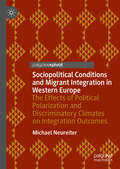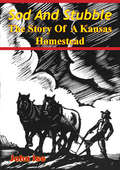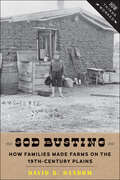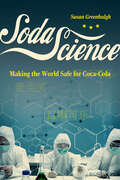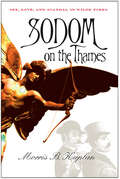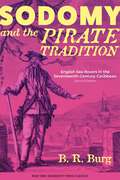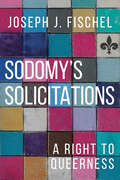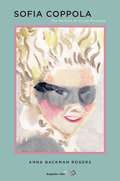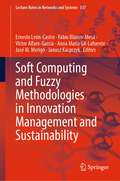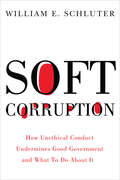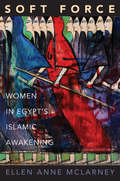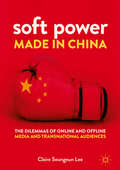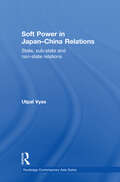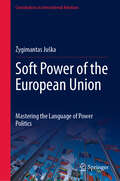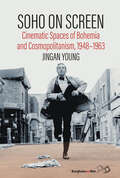- Table View
- List View
Sociopolitical Conditions and Migrant Integration in Western Europe: The Effects of Political Polarization and Discriminatory Climates on Integration Outcomes
by Michael NeureiterThis book brings new insight from social psychology to explore migrant integration in Western Europe. Through a series of survey studies it illustrates the importance of sociopolitical conditions, such as political polarization and discriminatory climates, for understanding cross-national variation in migrant integration outcomes. The author investigates how migrants integrate; what factors facilitate or hinder successful integration; and how successes and failures along the way affect subsequent integration outcomes. An inspiring read for researchers and students alike interested in migration studies, political behaviour, social psychology, and international policy, this book aims to promote more effective migrant integration policies within the European Union and elsewhere.
Sod And Stubble; The Story Of A Kansas Homestead: The Story Of A Kansas Homestead
by John Ise"A few years ago, as I listened one night to my mother telling incidents of her life pioneering in the semi-arid region of Western Kansas, it occurred to me that the picture of that early time was worth drawing and preserving for the future, and that, if this were ever to be done, it must be done soon, before all of the old settlers were gone. This book is the result-an effort to picture that life truly and realistically. It is the story of an energetic and capable girl, the child of German immigrant parents, who at the age of seventeen married a young German farmer, and moved to a homestead on the wind-swept plains of Kansas, where she reared eleven of her twelve children, and remembering regretfully her own half-day in school, sent nine of them through college. It is a story of grim and tenacious devotion in the face of hardships and disappointments, devotion that never flagged until the long, hard task of near a lifetime was done."--John Ise (from the preface) Deeply moved by his mother's memories of a waning era and rapidly disappearing lifestyle, John Ise painstakingly recorded the adventures and adversities of his family and boyhood neighbors--the early homesteaders of Osborne County, Kansas. First published in 1936, his "nonfiction novel" Sod and Stubble has since become a widely read and much loved classic. In the original, Ise changed some identities and time sequences but accurately retained the uplifting and disheartening realities of prairie life. Ushering us through a dynamic period of pioneering history, from the 1870s to the turn of the century, Sod and Stubble abounds with the events and issues--fires and droughts, parties and picnics, insect infestations and bumper crops, prosperity and poverty, divisiveness and generosity, births and deaths--that shaped the lives and destinies of Henry and Rosa Ise, their family, and their community.-Print ed.
Sod Busting: How Families Made Farms on the 19th-Century Plains (How Things Worked)
by David B. Danbom“An excellent introduction to the challenges and opportunities of agricultural life in a difficult region for farming . . . elegantly written.” —Jeff Bremer, The Annals of IowaPrairie busting is central to the lore of westward expansion, but how was it actually accomplished with little more than animal and human power? In Sod Busting, David B. Danbom challenges students to think about the many practicalities of surviving on the Great Plains in the late nineteenth century by providing a detailed account of how settlers acquired land and made homes, farms, and communities. He examines the physical and climatic obstacles of the plains—perhaps America’s most inhospitable frontier—and shows how settlers sheltered themselves, gained access to fuel and water, and broke the land for agriculture.Treating the Great Plains as a post-industrial frontier, Danbom delves into the economic motivations of settlers, how they got the capital they needed to succeed, and how they used the labor of the entire family to survive until farms returned profits. He examines closely the business decisions that determined the success or failure of these farmers in a boom-and-bust economy; details the creation of churches, schools, and service centers that enriched the social and material lives of the settlers; and shows how the support of government, railroads, and other businesses contributed to the success of plains settlement.Based on contemporary accounts, settlers’ reminiscences, and the work of other historians, Sod Busting dives deeply into the practical realities of how things worked to make vivid one of the quintessentially American experiences, breaking new land.“A cogent and engaging portrait of the real lives of those who settled the Great Plains.” —Nebraska History
Soda Science: Making the World Safe for Coca-Cola
by Susan GreenhalghTakes readers deep inside the secret world of corporate science, where powerful companies and allied academic scientists mold research to meet industry needs. The 1990s were tough times for the soda industry. In the United States, obesity rates were exploding. Public health critics pointed to sugary soda as a main culprit and advocated for soda taxes that might decrease the consumption of sweetened beverages—and threaten the revenues of the giant soda companies. Soda Science tells the story of how industry leader Coca-Cola mobilized allies in academia to create a soda-defense science that would protect profits by advocating exercise, not dietary restraint, as the priority solution to obesity, a view few experts accept. Anthropologist and science studies specialist Susan Greenhalgh discovers a hidden world of science-making—with distinctive organizations, social networks, knowledge-making practices, and ethical claims—dedicated to creating industry-friendly science and keeping it under wraps. By tracing the birth, maturation, death, and afterlife of the science they made, Greenhalgh shows how corporate science has managed to gain such a hold over our lives. Spanning twenty years, her investigation takes her from the US, where the science was made, to China, a key market for sugary soda. In the US, soda science was a critical force in the making of today’s society of step-counting, fitness-tracking, weight-obsessed citizens. In China, this distorted science has left its mark not just on national obesity policies but on the apparatus for managing chronic disease generally. By following the scientists and their ambitious schemes to make the world safe for Coke, Greenhalgh offers an account that is more global—and yet more human—than the story that dominates public understanding today. Coke’s research isn’t fake science, Greenhalgh argues; it was real science, conducted by real and eminent scientists, but distorted by its aim. Her gripping book raises crucial questions about conflicts of interest in scientific research, the funding behind familiar messages about health, and the cunning ways giant corporations come to shape our diets, lifestyles, and health to their own needs.
Sodom on the Thames
by Morris B. KaplanSodom on the Thames looks closely at three episodes involving sex between men in late-nineteenth-century England. Morris Kaplan draws on extensive research into court records, contemporary newspaper accounts, personal correspondence and diaries, even a pornographic novel. He focuses on two notorious scandals and one quieter incident. In 1871, transvestites "Stella" (Ernest Boulton) and "Fanny" (Frederick Park), who had paraded around London's West End followed by enthusiastic admirers, were tried for conspiracy to commit sodomy. In 1889–1890, the "Cleveland Street affair" revealed that telegraph delivery boys had been moonlighting as prostitutes for prominent gentlemen, one of whom fled abroad. In 1871, Eton schoolmaster William Johnson resigned in disgrace, generating shockwaves among the young men in his circle whose romantic attachments lasted throughout their lives. Kaplan shows how profoundly these scandals influenced the trials of Oscar Wilde in 1895 and contributed to growing anxiety about male friendships. Sodom on the Thames reconstructs these incidents in rich detail and gives a voice to the diverse people involved. It deepens our understanding of late Victorian attitudes toward urban culture, masculinity, and male homoeroticism. Kaplan also explores the implications of such historical narratives for the contemporary politics of sexuality.
Sodomites, Pederasts, and Tribades in Eighteenth-Century France: A Documentary History
by Jeffrey MerrickIn this book, Jeffrey Merrick brings together a rich array of primary-source documents—many of which are published or translated here for the first time—that depict in detail the policing of same-sex populations in eighteenth-century France and the ways in which Parisians regarded what they called sodomy or pederasty and tribadism. Taken together, these documents suggest that male and female same-sex relations played a more visible public role in Enlightenment-era society than was previously believed.The translated and annotated sources included here show how robust the same-sex subculture was in eighteenth-century Paris, as well as how widespread the policing of sodomy was at the time. Part 1 includes archival police records from the 1720s to the 1780s that show how the police attempted to manage sodomitical activity through surveillance and repression; part 2 includes excerpts from treatises and encyclopedias, published nouvelles (collections of news) and libelles (libelous writings), fictive portrayals, and Enlightenment treatments of the topic that include calls for legal reform. Together these sources show how contemporaries understood same-sex relations in multiple contexts and cultures, including their own. The resulting volume is an unprecedented look at the role of same-sex relations in the culture and society of the era.The product of years of archival research curated, translated, and annotated by a premier expert in the field, Sodomites, Pederasts, and Tribades in Eighteenth-Century France provides a foundational primary text for the study and teaching of the history of sexuality.
Sodomites, Pederasts, and Tribades in Eighteenth-Century France: A Documentary History
by Jeffrey MerrickIn this book, Jeffrey Merrick brings together a rich array of primary-source documents—many of which are published or translated here for the first time—that depict in detail the policing of same-sex populations in eighteenth-century France and the ways in which Parisians regarded what they called sodomy or pederasty and tribadism. Taken together, these documents suggest that male and female same-sex relations played a more visible public role in Enlightenment-era society than was previously believed.The translated and annotated sources included here show how robust the same-sex subculture was in eighteenth-century Paris, as well as how widespread the policing of sodomy was at the time. Part 1 includes archival police records from the 1720s to the 1780s that show how the police attempted to manage sodomitical activity through surveillance and repression; part 2 includes excerpts from treatises and encyclopedias, published nouvelles (collections of news) and libelles (libelous writings), fictive portrayals, and Enlightenment treatments of the topic that include calls for legal reform. Together these sources show how contemporaries understood same-sex relations in multiple contexts and cultures, including their own. The resulting volume is an unprecedented look at the role of same-sex relations in the culture and society of the era.The product of years of archival research curated, translated, and annotated by a premier expert in the field, Sodomites, Pederasts, and Tribades in Eighteenth-Century France provides a foundational primary text for the study and teaching of the history of sexuality.
Sodomy and the Pirate Tradition: English Sea Rovers in the Seventeenth-Century Caribbean, Second Edition
by B. R. BurgExplores the sexual world of the one of the most fabled and romanticized characters in history—the pirateFrom Blackbeard to Captain Hook, pirates have been the subject of countless movies, books, children's tales, and even a world-famous amusement park ride. In Sodomy and the Pirate Tradition, B.R. Burg looks beyond the myth to analyze the social and sexual world of sea rovers. Through his innovative analysis of archival materials, he uncovers the queer history of piracy.Burg makes the groundbreaking argument that buccaneer sexuality differed widely from that of other all-male institutions such as prisons. Instead of existing within a regimented structure of rule, regulations, and oppressive supervision, buccaneers operated in a society in which widespread tolerance of homosexuality was the norm and conditions encouraged its practice.Sodomy and the Pirate Tradition has helped to reshape the figure of the pirate for a new century. In Burg’s introduction, he discusses the controversy that surrounded the book when it was published in 1983 and how our perspectives on all-male societies have since changed. Creating an indelible impact on our culture, the book was even read by Johnny Depp in preparation for his role of Captain Jack Sparrow. In a time when we are rethinking conventional historical narratives, Sodomy and the Pirate Tradition offers an essential, alternative perspective on the centuries-old figure of the pirate.
Sodomy's Solicitations: A Right to Queerness (Sexuality Studies)
by Joseph J. FischelJoseph Fischel’s provocative book, Sodomy’s Solicitations, builds out a politics of sexual justice that challenges state sex exceptionalism. By tracing several twenty-first century contestations around Louisiana anti-sodomy laws, Fischel examines patterns and practices of sexual injustice that are too easily eclipsed by our collective focus on marginalized identities. The political stories narrated in Sodomy’s Solicitations are undoubtedly stories of racism, sexism, homophobia, and transphobia, but they are also stories of other political problems—and political possibilities. Fischel indicts U.S. sex offender regulatory regimes as state-sponsored sexual violence; offers a qualified defense for sexual expression in public; and argues that animal sexual abuse laws, with their exemptions for industrial agricultural practices, authorize the suffering they were enacted to deter. He also makes the case that laws criminalizing the exchange of sex for money are unconstitutional, and proposes that the best way to protect trans and queer children might just be to enfranchise them. Sodomy’s Solicitations champions a right to queerness across rather than within identity formations—a right to relatively unpoliced gender, sexual, and intimate pluralism. In the series Sexuality Studies
Sofia Coppola: The Politics of Visual Pleasure
by Anna Backman RogersA feminist study of the mood, texture, tone, and multifaceted meaning of director Sofia Coppola’s aesthetic through her most influential and well-known films. A Choice Outstanding Academic Title 2019 “With this book Rogers has produced a sophisticated and impassioned analysis of Coppola’s work… Rogers’s main argument – that Coppola manipulates pleasurable images to unsettle rather than mollify us – is utterly convincing. If nothing else, this certainly hits home in relation to my own enchantment with Coppola’s work.”—Bright Lights Film Journal All too often, the movies of Sofia Coppola have been dismissed as “all style, no substance.” But such an easy caricature, as this engaging and accessible survey of Coppola’s oeuvre demonstrates, fundamentally misconstrues what are rich, ambiguous, meaningful films. Drawing on insights from feminist philosophy and psychology, the author here takes an original approach to Coppola, exploring vital themes from the subversion of patriarchy in The Virgin Suicides to the “female gothic” in The Beguiled. As Rogers shows, far from endorsing a facile and depoliticized postfeminism, Coppola’s films instead deploy beguilement, mood, and pleasure in the service of a robustly feminist philosophy. From the Introduction: Sofia Coppola possesses a highly sophisticated and intricate knowledge of how images come to work on us; that is, she understands precisely how to construct an image – what to add in and what to remove – in order to achieve specific moods, tones and cinematic affects. She knows that similar kinds of images can have vastly different effects on the viewer depending on their context…. This monograph is an extended study of Coppola’s outstanding ability to think through and in images.
Soft Computing and Fuzzy Methodologies in Innovation Management and Sustainability (Lecture Notes in Networks and Systems #337)
by Anna Maria Gil-Lafuente Janusz Kacprzyk José M. Merigó Ernesto León-Castro Fabio Blanco-Mesa Victor Alfaro-GarcíaThis book provides recent research on soft computing and fuzzy methodologies in innovation management and sustainability. The uncertainty in the business world is increasing. Significant changes are generated unexpectedly, so using fuzzy logic and soft computing methods allows us to create flexible scenarios adaptable to new realities. Within the book, we will find different applications of fuzzy methodologies that can apply to various topics such as sustainability, innovation, tourism, costs, exports, systems administration, among others. The book's main contribution is the applicability of the various methodologies to specific cases, which allows generating a relationship between theory and practice. In addition, it has some bibliometric studies on various topics that give us a visualization of what has happened and where multiple topics are headed. This book is recommended mainly for students who wish to know how the various fuzzy and soft computing tools can be taken to real situations, allowing a better understanding of these and generating new visions of future applicability.
Soft Corruption: How Unethical Conduct Undermines Good Government and What To Do About It
by William E. SchluterNew Jersey has long been a breeding ground for political corruption, and most of it is perfectly legal. Public officials accept favors from lobbyists, give paid positions to relatives, and rig the electoral process to favor their cronies in a system where campaign money is used to buy government results. Such unethical behavior is known as “soft corruption,” and former New Jersey legislator William E. Schluter has been fighting it for the past fifty years. In this searing personal narrative, the former state senator recounts his fight to expose and reform these acts of government misconduct. Not afraid to cite specific cases of soft corruption in New Jersey politics, he paints a vivid portrait of public servants who care more about political power and personal gain than the public good. By recounting events that he witnessed firsthand in the Garden State, he provides dramatic illustrations of ills that afflict American politics nationwide. As he identifies five main forms of soft corruption, Schluter diagnoses the state government’s ethical malaise, and offers concrete policy suggestions for how it might be cured. Not simply a dive through the muck of New Jersey politics, Soft Corruption is an important first step to reforming our nation’s political system, a book that will inspire readers to demand that our elected officials can and must do better. Visit: www.softcorruption.com (http://www.softcorruption.com)
Soft Force: Women in Egypt's Islamic Awakening
by Ellen Anne MclarneyIn the decades leading up to the Arab Spring in 2011, when Hosni Mubarak's authoritarian regime was swept from power in Egypt, Muslim women took a leading role in developing a robust Islamist presence in the country's public sphere. Soft Force examines the writings and activism of these women--including scholars, preachers, journalists, critics, actors, and public intellectuals--who envisioned an Islamic awakening in which women's rights and the family, equality, and emancipation were at the center.Challenging Western conceptions of Muslim women as being oppressed by Islam, Ellen McLarney shows how women used "soft force"--a women's jihad characterized by nonviolent protest--to oppose secular dictatorship and articulate a public sphere that was both Islamic and democratic. McLarney draws on memoirs, political essays, sermons, newspaper articles, and other writings to explore how these women imagined the home and the family as sites of the free practice of religion in a climate where Islamists were under siege by the secular state. While they seem to reinforce women's traditional roles in a male-dominated society, these Islamist writers also reoriented Islamist politics in domains coded as feminine, putting women at the very forefront in imagining an Islamic polity.Bold and insightful, Soft Force transforms our understanding of women's rights, women's liberation, and women's equality in Egypt's Islamic revival.
Soft Power Made in China: Transnational Audiences And The Dilemmas Of Online And Offline Media
by Claire Seungeun LeeThis book analyzes the ways in which China’s soft power growth faces dilemmas in East Asia through both online and offline platforms. One dilemma for China’s transnational soft power-field expansion lies in the intersection of its source and receiving countries. The author discusses how transnational audiences’ consumption and reception of Chinese television series are shaped by domestic factors, with interpretations of and desires for different forms of capital, further inhibiting the foreign export of these series. Another dilemma is the “outsourced soft power.” While Hong Kong and Taiwan play significant roles as outsourced soft power mediators, their under-established emerging digital media platforms have yet to meet the expectations of transnational audiences in a virtual transnational soft power field. Grounded in the author’s multi-site field research focused on television spheres, Soft Power Made in China argues that China’s soft power paradox in South Korea and Japan—two quasi-Sinophone countries—is not due to a lack of state-level strategy, but linked to soft power pathways that rely on production in one source country, and both distribution and reception in a receiving country.
Soft Power With Chinese Characteristics: China’s Campaign for Hearts and Minds
by Stanley Rosen Ying Zhu Kingsley EdneyThis book examines the Chinese Communist Party’s attempts to improve China’s image around the world, thereby increasing its "soft power." This soft, attractive form of power is crucial if China is to avoid provoking an international backlash against its growing military and economic might. The volume focuses on the period since Xi Jinping came to power in 2012, and is global in scope, examining the impact of Chinese policies from Hong Kong and Taiwan to Africa and South America. The book explains debates over soft power within China and delves into case studies of important policy areas for China’s global image campaign, such as film, news media and the Confucius Institutes. The most comprehensive work of its kind, the volume presents a picture of a Chinese leadership that has access to vast material resources and growing global influence but often struggles to convert these resources into genuine international affection. Soft Power With Chinese Characteristics will be invaluable to students and scholars of Chinese politics and Chinese media, as well as international relations and world politics more generally.
Soft Power and Heritage (The Latin American Studies Book Series)
by Rodrigo ChristofolettiThis book encourages a critical dialogue between interdisciplinary fields that border heritage boundaries and seeks to contribute a wide range of scholarly perspectives and case studies (both national and international). The widespread use of the concept of soft power is sometimes grossly misused as a synonym for anything other than military force. While the concept is one of the most popular and influential in progressive foreign policy circles and is noted for being the ability of a country to convince others that its cause is the best, without having to resort to economic or military threats, the your ability to accurately describe the world we live in needs repair lenses. The power of example, the power of attraction through culture or, in other words, the ability of a country to attract others because of its culture and political values in its foreign policy, that is, soft power, is something that emerges in partly because of government and partly in spite of governments. To have soft power, you need to be connected, and the interaction, management and dissemination of assets can be seen as exercises in soft power action. This book seeks to detail in examples how the concept of “soft power” encompasses and problematizes the multiplicity of themes on the contemporary international agenda, focusing on one of its least discussed elements: the universe of international cultural heritage and the relationship between actors and society, preservationist actions in the globalized world. While cultural heritage embodies different values and can serve different economic, social and political objectives in development contexts, the past becomes a cultural currency when it becomes essential to the human experience.
Soft Power in Japan-China Relations: State, sub-state and non-state relations (Routledge Contemporary Asia Series)
by Utpal VyasSoft power has tended to be overlooked in the field of international relations, often dismissed as lacking relevance or robustness as a theoretical concept. This book seeks to expand upon the idea of ‘soft power’ in international relations and to investigate how it actually functions by looking at three case studies in Japan-China relations during the post-war period. These cases involve the action of Japan’s soft power in China due to the activities of agents at three levels in society: the state level (an agency of the central government), the sub-state level (a local government), and at the non-state level (a non-governmental organisation). In addition, a major theme of the book is to examine the role of important international actors whose roles are not covered sufficiently in international relations discourse. Utpal Vyas demonstrates ways in which soft power is a useful analytical tool to understand relations between China and Japan in the early 2000s. The case studies help to reveal the complexities of interaction between China and Japan beyond the usual state-level analyses and offer a valuable resource for the study of Sino-Japanese relations and IR in general. This book will be of interest to academics and postgraduate students in Japanese studies, Chinese studies and International Relations.
Soft Power of the European Union: Mastering the Language of Power Politics (Contributions to International Relations)
by Žygimantas JuškaThis book sheds light on the complexities of the European Union's (EU) influence in a world dominated by global power politics. Written by an EU diplomat, it explores the dynamic landscape of soft power, with a focus on key regions such as the Western Balkans, Eastern Partnership, Southern Neighborhood, and Sub-Saharan Africa. Presenting the economic, diplomatic, and cultural dimensions, the book critically evaluates the EU's effectiveness in shaping behavior amid intensifying global power competition. With a unique perspective gained from on-the-ground experience in Kosovo, Ukraine, and Rwanda, the author navigates the EU's responses to challenges, including Russia's hard power approach. A must-read for policymakers and diplomats, this book blends academic analysis with practical insights, offering valuable lessons and recommendations for mastering the language of power in today's global politics. Ideal for students and professionals, it provides a comprehensive explorationof EU foreign policy dynamics.
Soft Target Hardening: Protecting People from Attack
by Jennifer HestermanThe US government spends billions of dollars to secure strategic and tactical assets at home and abroad against enemy attack. However, as "hard targets" such as military installations and government buildings are further strengthened, vulnerable soft targets are increasingly in the crosshairs of terrorists and violent criminals. Attacks on crowded spaces such as churches, schools, malls, transportation hubs, and recreational venues result in more casualties and have a powerful effect on the psyche of the populace. Soft Target Hardening: Protecting People from Attack, Second Edition, continues the national dialogue started by the first edition by providing case studies, best practices, and methodologies for identifying soft target vulnerabilities and reducing risk in the United States and beyond. Soft target attacks steadily climbed in number and scale of violence since the first edition of this book. New tactics emerged, as terrorists continually hit the "reset button" with each attack. In this volatile, ever-changing security environment, plans to protect people and property must be fluid and adaptable. Along with new hardening tactics, such as the use of tactical deception to disguise, conceal, and divert, the author has updated the text with new case studies to reflect and respond to the fast-moving transformation in methods from more complex and organized forms of terror to simpler, yet still-devastating approaches. This book is a must-read for those who secure, own, and operate soft target facilities, and for citizens who want to protect themselves and their families from attack.
Soft Target Protection: Theoretical Basis and Practical Measures (NATO Science for Peace and Security Series C: Environmental Security)
by Ladislav Hofreiter Viacheslav Berezutskyi Lucia Figuli Zuzana ZvakováThis proceedings volume includes articles presented during the Advanced Research Workshop on Soft Target Protection. The book presents important topics related to the protection of vulnerable objects and spaces, called Soft Targets. The chapters published in this book are thematically assigned to the blocks as follows: Theoretical aspect of soft target protection; Blast resistance of soft targets; Counter terrorism; Technical and technological solutions for soft target protection; Scheme and organizational measures; Blast protection and Forces for soft target protection. In this book, the reader will find a wealth of information about the theoretical background for designing protection of soft targets, as well as the specifics of protecting objects in armed conflict areas. New methods and procedures applicable to the soft target protection are described.
Soft Targets and Crisis Management: What Emergency Planners and Security Professionals Need to Know
by Jennifer Hesterman Michael J. FagelUniting the best of Michael Fagel and Jennifer Hesterman's books in the fields of homeland security and emergency management, the editors of this volume present the prevailing issues affecting the homeland security community today. Many natural and man-made threats can impact our communities—but these well-known and highly respected authors create order from fear, guiding the reader through risk assessment, mitigation strategies, community EOC planning, and hardening measures based upon real-life examples, case studies, and current research in the practice. As terrorist attacks and natural disasters continue to rock the world, Soft Targets and Crisis Management emphasizes the vulnerability of soft targets like schools, churches, and hospitals, and presents the methodology necessary to respond and recover in the event of a crisis in those arenas. Features: Based on ASIS award-winning texts Provides a multi-faceted look at crisis management principles Offers community-specific examples for diverse locales and threat centers Includes up-to-date case studies on soft target attacks from around the world A must-read for security, emergency management, and criminal justice professionals, Soft Targets and Crisis Management: What Emergency Planners and Security Professionals Need to Know is a crucial text for practitioners seeking to make the world a safer place for others.
Soho on Screen: Cinematic Spaces of Bohemia and Cosmopolitanism, 1948-1963
by Jingan YoungDespite Soho’s rich cultural history, there remains an absence of work on the depiction of the popular neighbourhood in film. Soho on Screen provides one of the first studies of Soho within postwar British cinema. Drawing upon historical, cultural and urban studies of the area, this book explores twelve films and theatrically released documentaries from a filmography of over one hundred Soho set productions. While predominantly focusing on low-budget, exploitation films which are exemplars of British and international filmmaking, Young also offers new readings of star and director biographies, from Laurence Harvey to Emeric Pressburger, and in so doing enlivens discussion on filmmaking in a time and place of intense social transformation, technological innovation and growing permissiveness.
Soho on Screen: Cinematic Spaces of Bohemia and Cosmopolitanism, 1948-1963
by Jingan YoungDespite Soho’s rich cultural history, there remains an absence of work on the depiction of the popular neighbourhood in film. Soho on Screen provides one of the first studies of Soho within post-war British cinema. Drawing upon historical, cultural and urban studies of the area, this book explores twelve films and theatrically released documentaries from a filmography of over one hundred Soho set productions. While predominantly focusing on low-budget, exploitation films which are exemplars of British and international filmmaking, Young also offers new readings of star and director biographies, from Laurence Harvey to Emeric Pressburger, and in so doing enlivens discussion on filmmaking in a time and place of intense social transformation, technological innovation and growing permissiveness.
Soho: A Street Guide to Soho's History, Architecture and People
by Dan CruickshankSoho - illicit, glamorous, sordid, louche, poverty-stricken, squalid, exhilarating. One of Britain's best-loved historians, Dan Cruickshank, grants us an intimacy with centuries of rich and varied history as he guides us around the Soho of the last five hundred years. We learn of its original aspirations towards respectability, how it became London's bohemian quarter and why it was once home to its criminal underworld. The bars, clubs, theatres and their frequenters are described with detail that evokes the heart of the district. The history of Soho is written in its surviving architecture. Cruickshank points out the streets that were the stamping grounds of criminal dynasties and directs our attention towards the homes of renowned prostitutes, revealing Georgian sexual mores and surprising visitors - amongst them eighteenth-century painter Joshua Reynolds, whose peculiar 'caprice' was simply drawing the girls. Soho has been home to characters as diverse as Mrs Goadby's girls to the Maltese mafia, and Cruikshank draws these threads together with kaleidoscopic verve. Even as he mourns some of the changes, he pays testament to the district's resilience. He observes how the common denominator over the centuries is that it has always been a destination for immigrants: from French Huguenots to the East European Jewish community and recent Chinese diaspora - and that this is the foundation of its spirit and success.
Soho: A Street Guide to Soho’s History, Architecture and People
by Dan CruickshankSoho - illicit, glamorous, sordid, louche, poverty-stricken, squalid, exhilarating. One of Britain's best-loved historians, Dan Cruickshank, grants us an intimacy with centuries of rich and varied history as he guides us around the Soho of the last five hundred years. We learn of its original aspirations towards respectability, how it became London's bohemian quarter and why it was once home to its criminal underworld. The bars, clubs, theatres and their frequenters are described with detail that evokes the heart of the district. The history of Soho is written in its surviving architecture. Cruickshank points out the streets that were the stamping grounds of criminal dynasties and directs our attention towards the homes of renowned prostitutes, revealing Georgian sexual mores and surprising visitors - amongst them eighteenth-century painter Joshua Reynolds, whose peculiar 'caprice' was simply drawing the girls. Soho has been home to characters as diverse as Mrs Goadby's girls to the Maltese mafia, and Cruikshank draws these threads together with kaleidoscopic verve. Even as he mourns some of the changes, he pays testament to the district's resilience. He observes how the common denominator over the centuries is that it has always been a destination for immigrants: from French Huguenots to the East European Jewish community and recent Chinese diaspora - and that this is the foundation of its spirit and success.
